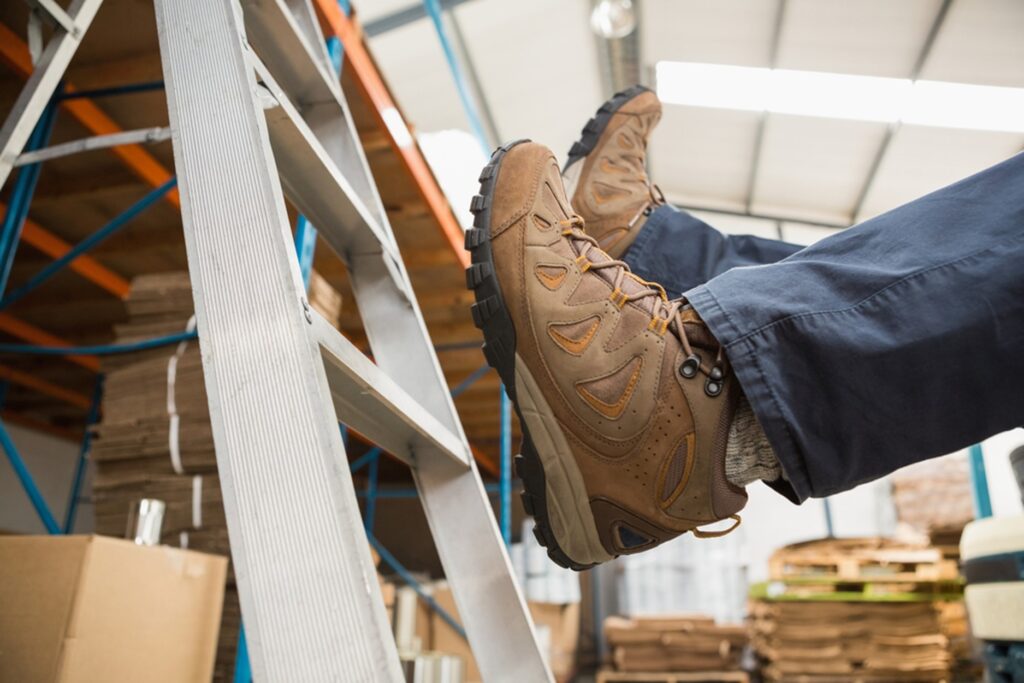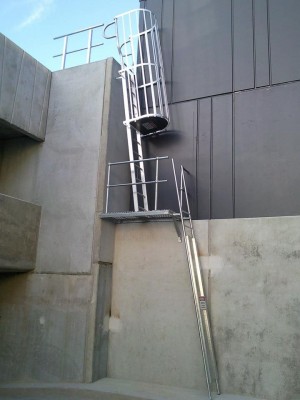Introduction
Managing the risk of falls is critical, especially regarding ladder use. This article aims to provide an insightful overview of the requirements in Section 9 of the Risk of Falls Model Code of Practice (COP), focusing on ladders.
The Importance of Ladder Safety
Every year, numerous workplace accidents are attributed to improper ladder usage. The COP is designed to mitigate these risks by establishing clear guidelines and best practices. Compliance is not just a legal obligation but a moral one, ensuring the safety and well-being of all employees.

Key Requirements of Ladder Safety
Ladder Selection
The Code emphasises the importance of choosing the right ladder for the task. This includes considering the ladder’s material, strength, and suitability for the environment and nature of the work.
Inspection and Maintenance
Regular inspections are mandatory to ensure ladders are in good condition. Any ladders that are damaged or defective must be repaired or replaced promptly.
Proper Use
The Code outlines specific protocols for setting up and using ladders. This includes ensuring stability, avoiding overreaching, and adhering to load limits.
Training and Supervision
Employees must be adequately trained in safe ladder use. This includes understanding how to assess risks and use ladders correctly. Supervision is also key, particularly for high-risk tasks.
Emergency Procedures
The COP also covers the need for clear emergency procedures in case of a fall or other ladder-related accidents.
Adhering to Managing the Risk of Falls COP is a regulatory requirement and a step towards fostering a ladder safety culture.
By understanding and implementing these guidelines, organisations can significantly reduce the risk of ladder-related incidents, ensuring a safer workplace.
Following the COP is the first step in doing everything reasonably practical towards ladder safety and managing safety in the workplace. This practice is your first line of defence to protect your staff and your business.
Portable Ladders
Portable ladders must comply with the relevant Australian Standards and guidelines. This is the first step in setting a benchmark for your ladder safety program. The following provides guidance:
- All ladders must comply with AS 1892, including legible SWL and other safety stickers.
- Isolate the work area to prevent others from accessing the fall zone.
- All ladders must be fully opened, locked and on a stable level surface.
- A second person must hold the ladder and assist the worker
- A ladder must never be ‘walked’ by the person standing on the ladder
- The word ‘walked’ above describes the action of a person standing at the top of a ladder who, by moving his body, causes the bottom of the ladder to lift the ends of the stiles, alternately causing the ladder to move. This is very dangerous since the ladder is not under control and is unstable.
- Set the ladder at a slope of 4 in 1 – 1 unit from the wall for every four units of height.
- Ladders must be firmly secured or tied off. If tied, the ties should be attached to the stiles of the ladder, not the rungs. While the ladder is in use, it must be held firmly by another person.
- One ladder – one person. Must have 3 points of contact at all times
- This means either two feet and one hand, or one foot and two hands on the ladder when ascending, descending, or working on the ladder. To achieve this, always carry your tools in a tool belt, holster or pouch, not in your hands. Never attach a power tool to the side of a ladder when it is not in use;
- Beware of contacting power lines when putting a ladder into position. If you must work near power lines, including supply lines into a building, have them de-energised, or insulated with ‘tiger tails’, before placing the ladder. In addition, any ladder used near power lines must be non-conducting, such as timber (without wire reinforcement, or with the wire reinforcement recessed and insulated) or reinforced plastics, but NOT aluminium or any metal and clearly marked for electrical service
- Never climb higher than the third rung from the top of the ladder;
- The ladder must have at least one metre (1.0 m) of solid support beyond the height of the task. Where it is necessary to get onto or off at the top of the ladder, it must extend at least 1.0 m above the level being accessed and be tied securely to the top level
- A ladder should be used as a means of access and not a place of work
- A suitable work platform must only be used to carry out any work at height
- Ladders must be placed in a manner that permits the worker to face towards both the ladder and the task without leaning over the side of the ladder.
- Ladders must not be used outdoors during weather, e.g. strong wind, rain
- Ladders are to be fitted with rubber (or similar non-slip material) feet to prevent slipping;
- If it is not practicable to tie off or secure a ladder for any reason, an alternative means of access must be used.
Extension Ladders – Additional Requirements
When using extension ladders, the following points must be observed:
- Extension ladders such as rope and pulley types are suitable for accessing high areas such as rooftops and tall trees. One specialist design is the pole ladder, which has a curved top rung to give the ladder stability when used for accessing a pole or round column. To erect a rope and pulley ladder, place the unextended ladder into position and then extend it a few rungs at a time, using the rope. Always ensure that the latching hooks are properly engaged after each extension;
- Do not use extension stepladders made before August 1996 that have spring clips to retain the extended rear legs, as these ladders are not safe. If the top of the ladder is above the wall – when a person steps off or onto the ladder the clips may disengage and allow the ladder to fold. These extension stepladders must never be used in this configuration. Such ladders do not conform to the requirements of AS/NZS 1892.1: 1996;
- Long ladders and heavy ladders (greater than 20 kg) should always be handled by two persons;
- Ladders should be positioned on stable level ground;
- Fully enclosed slip-resistant footwear must always be worn when using ladders;
- Ladders should be stored under cover, with adequate support to prevent sagging;
- Ladders are to be inspected before use and any defects or deterioration repaired before further use. Wooden ladders should never be painted. If a preservative is used, it should be transparent and remain transparent during the life of the ladder to enable visual inspections to detect deterioration or defects;
- Damaged ladders should be tagged “Out of Service” until they are repaired by a competent person or destroyed in such a manner as to render them useless, e.g. by cutting into lengths of approximately 1.0 m or not more than two rungs;
Domestic ladders must not be used in any workplace.
Fixed Ladders
Fixed ladders need to be set up following AS 1657–2018 standards, focusing on the design and installation of fixed platforms and ladders. While ladder cages on steep ladders (over 75 degrees) don’t prevent falls and can complicate rescues, it’s recommended to equip such ladders with fall arrest systems, like anchorage lines.
The slope of these ladders should be between 70 and 75 degrees. For ladders steeper than 75 degrees, additional fall prevention measures, like a full-body harness, are necessary.
It’s also crucial to have a rescue plan specifically for ladder cage scenarios and to train personnel in these procedures before they use the ladder.

Ladder Maintenace
A competent person should regularly inspect ladders following the manufacturer’s recommendations. Ladder maintenance is a key fundamental of good ladder safety.
Ladders with any of the following faults should be replaced or repaired:
- fibreglass stiles cracked, chipped or severely faded with fibres exposed
- timber stiles warped, splintered, cracked or bruised
- metal stiles twisted, bent, kinked, crushed or with cracked welds
- rungs, steps, treads or top plates that are missing, worn, damaged or loose
- tie rods missing, broken or loose
- ropes, braces or brackets that are missing broken or worn
- timber members that are covered with opaque paint or other treatment that could disguise faults in the timber
- missing, loose, bent or worn fasteners, that is rivets, bolts and pins, and/or
- worn or damaged feet, including non-slip material.
Conclusion
Adhering to Managing the Risk of Falls COP is a regulatory requirement and a step towards fostering a safety culture and ladder safety.
By understanding and implementing these guidelines, organisations can significantly reduce the risk of ladder-related incidents, ensuring a safer workplace.
Following the COP is the first step in doing everything reasonably practical to manage safety in the workplace and is your first line of defence to protect your staff and your business.
For further guidance on your responsibilities, the article Falls in the Workplace is the Responsibility of Everyone.